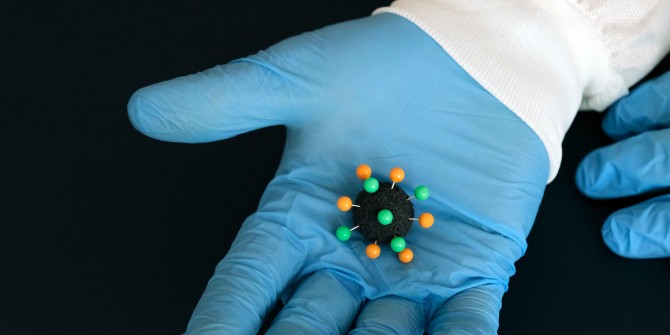For the CEO of a medical research company, COVID-19 presents particular challenges. LSE alumnus Renzo DiCarlo describes how his medical research company decided early on to focus on control and prevention of the virus, rather than detection and tracing.
It is now nine months since I began working with clients in Wuhan, China who were worried about a rapidly-spreading new virus. BioPharma Services (BPSI) is a medical research company that carries out Phase 1 drug development on many treatments, including COVID-19 therapeutics. This put us in an extraordinary position during the pandemic.
My advice to peers, colleagues and leaders in industry is never to take anything for granted in this new normal. A degree of paranoia has not only enabled us to survive but to develop new solutions. Business leaders need to anticipate infection risks, check biological data and act early.

Anticipating risks means analysing the marketplace, community, and your company to put in solutions that are ahead of the economic and pandemic curve. For example, it was clear in January from initial spread data in Wuhan that the R0 (transmission value) of COVID-19 was significantly higher than the flu virus, which has an R0 of between 0.8 and 1.8. With an R0 of 2.5 to 4, COVID-19’s ability to spread is two to three times higher than the flu.
In February 2020, we convened a COVID governance meeting at our company to discuss ways to keep our staff, patients, and community safe while still conducting much-needed clinical research trials. This governance committee was made up of scientists, MDs and business executives, who met weekly. The resulting policies allowed us to stay open and flourish by focusing on preventative and control measures, rather than detection and tracing. Our doctors had worked on SARS-Ver 1 in the early 2000s, which gave us with insights not readily available in the marketplace.
We took the decision to focus on monitoring biological metrics and implementing a 100% mask policy within our facilities. This decision was taken months in advance of any public health mandates to wear masks. Our site is safer than a hospital, and we are not overloading the public health system with non-critical PCR COVID testing.
Unfortunately, other North American companies who focused on testing rather than prevention of spread were forced to shut down periodically, deep clean often and quarantine large numbers of staff due to super-spreading scenarios. These could have been prevented by controlling the spread within their facility, rather than trying to detect infected individuals.
I recommend that leaders and people check and verify all biological data in this new reality. The data being provided by institutions, companies and government needs to be verified, and triple-checked. At the end of March, one of our employees had developed COVID symptoms four days after their last shift. We got the public health result showing our employee was indeed positive one week after this initial notification. Proper procedures were followed to verify that the person was always wearing a mask during her last shift, no one had encountered her during her time at work, and the facility had been deep cleaned two days after her last shift. (The definition of ‘encounter’ as per our procedures is no one coming within two metres of the employee during her work shift.) Our main concern in this case – for the employee and our staff – was determining when it would be safe for her to return to work. Public Health had told us we should quarantine her at home for two weeks, which was consistent with our COVID Positive Response Plan (PRP). They stated that the employee could return to work after two weeks if symptoms had been resolved, with no need for a new COVID PCR test.
Due to the sensitivity of our clinical trials, we had mandated testing requirements above the public health minimum which required additional testing, and specifically two negative results in a row prior to returning to work. The employee, being a medical professional, complied with these additional requirements. We received a negative result for the first test but a positive on the subsequent test one week after. In the early days, it was hard to determine if the person had been reinfected, if test error had occurred, or if a proper sample was obtained. Even now, central laboratories admit that current testing has a large margin of error, requiring that you always test, re-test and verify data. Due to the hypersensitivity of the community and our staff, we took nothing for granted and asked the now asymptomatic employee to re-quarantine for another two weeks and redo the double tests. We eventually got the two negative tests in a row and the employee is safe and back at work.
More importantly, this one incident did not cause a major spread in our facility and avoided the need for a full shutdown of the site. This experience taught us to stay vigilant, manage fears and verify the data. By being so rigorous and demonstrating this to our clients and staff, they feel safer at BioPharma than most community hospitals.
Being proactive has proved vital. Developing a PRP early on allowed us to perfect it in real time with active COVID cases. The original PRP was developed by mapping out and creating theoretical “what if” scenarios, should someone should test positive for COVID. The PRP that exists today is infinitely better and more nuanced than the untested version in March 2020. The reasons for its success are policies centered around time, distance, and barriers to minimise spread.
In May, an employee confirmed that her mother, whom she lived with, had tested positive for COVID. As per our PRP, we isolated our employee for two weeks and asked for the double negative test before returning to work. Because both mother and daughter were trained medical professionals, they used time, distancing, and barrier techniques to minimise contamination between each other. The mother’s symptoms resolved, and she eventually tested negative. To our pleasant surprise, our employee never became COVID positive even though she lived with her. Masks, isolation and staying two metres apart proved to be quite effective, even for two individuals living in the same household. This taught us early on that good safety practices and procedures go a long way to minimising the spread. With the data from this case, PRP specifics were updated to make it more robust and relevant. We continue to be vigilant and proactive by continuously improving our PRP with real data as cases continue to arise, as testing quality evolves, and safety guidelines improve.
Lastly, business leaders need to act early, even if not all the data is present. BPSI volunteered and donated its Research & Development clinic for COVID research in February 2020, when the virus was not considered a threat to more developed countries and had not yet been declared a pandemic. This resulted in numerous unsolicited requests in the following months for help with coronavirus therapeutic drug development, using our assets and expertise.
This post represents the views of the author and not those of the COVID-19 blog, nor LSE.





